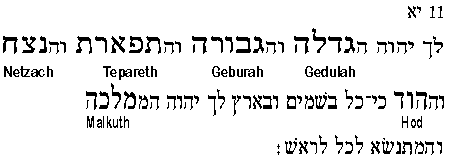
NOTE: If you see trash in this document and are using Windows go to The Hebrew Multimode Font, download the font and install it. This font is widely used in web pages in order to render Hebrew so it will be worth your time, plus it's free !
This text is drawn from my personal understanding of several works, check out the Library for a complete list.
A Short Introduction to the Kabbalah
At the beginning of the first century AD several major forms of Jewish mysticism began to evolve. The apocalyptic writings began to emerge such as the Book of Enoch, which contained the roots of two further developments crystallizing around the first chapter of Ezikiel and the book of Genisis. These schools of writing represent the presence of a strongly Gnostic strain of thought, forming a sort of Jewish Gnosticism.
Ma’aseh Merkabah or The Work of the Chariot is a system of
mysticism that arose during the 1st century AD based on the first chapter of
Ezekiel. It focused on the throne of God, it’s structure and the world in which it
existed. The world of the chariot is broken into palaces through which the chariot
traveled. The system details these palaces and presents a method of meditation and magic
to ascend through the palaces to the throne of God on the chariot itself. Other
concepts addressed include the structure of the Throne, the veil (parzod) concealing God
on the throne, the glory of God (kavod) behind this veil, and complex lists and
associations of angels.
This school of mysticism had a marked effect on the development of specific Jewish prayers and on the order of the prayers. Merkabah thought is found in the Dead Sea Scrolls where angels praise "the image of the Throne of the Chariot". A tradition of poetry or hymns developed, used by the aspirant to ascend, sometimes presented as the songs of the hayyot (holy creatures who bear the throne of glory) mentioned in apocalyptic literature.
Fragments of an earlier mystical tradition known as the Shi’ur Komah (measurements of the body of God) appear in Ma’aseh Merkabah writings. These often take the form of commentary on the Song of Songs. These fragments concern themselves with fantastic measurements of various portions of the body of God thought to be writings on the qualities of God.
Ma’aseh Bereshith or The Work of Creation is a system of mysticism formed around the book of Genisis. It is mainly concerned with the process and nature of creation. An extremely influential work on the Kabbalah arose based on the thought of this school of mysticism, the Sefir Yetzirah or book of formation, where the sephiroth are first mentioned and the significance of the letters of the Hebrew alphabet are mentioned along with attributions. Scholars heavily dispute the time period in which this work was written but an early date seems appropriate, sometime between the third and sixth centuries AD.
The text of this book uses terms associated with the Ma’aseh Merkabah tradition to describe the sephiroth associating them with the mythical creatures who bear the throne of glory (hayyot). The idea is conveyed that the universe was created through the speech of god, beginning with thought that materialized through language to become reality. All things came into being through the 231 gates being two letter combinations of the 22 letters of the Hebrew alphabet, possibly based on the roots of the Hebrew verbs. All things exist by the power of the Hebrew alphabet whose foundation is in one name, the Tetragrammaton, Yud Heh Vahv Heh (HWHY). The Sefir Yetzirah is now found in two forms, a long and short version.
Between the 6th and 13th centuries AD true kabbalistic ideas began to arise as several groups of Jewish mystics began to combine the ideas of the above systems of Jewish Mysticism with philosophy and neo-platonism. The Jewish communities of Spain, particularly in Provence, produced writers such as Abraham B. David and his son Isaac the Blind. Parallel to this development a sect of Judaism known as the Hasidei Ashkenaz arose in France and Germany. This was a sect teaching extremism in ethical and religious behavior (Hasid means piety) using Kabbalistic thought extensively in their writings.
The Sefir Ha-Bahir appeared during this time, reported to have come from the east. This book is the earliest book we can truly call Kabbalistic, expounding a system of Sephiroth where each is a divine attribute. It also is the earliest book interpreting the scriptures as allegory actually describing events occurring in the divine realm in place of or along with orthodox interpretations. It uses explanation of scripture to present Kabbalistic ideas.
Important ideas presented in this book include the idea that the Sephiroth are mentioned throughout scripture called by many names and describe the activities of the divine. The idea of the transmigration of souls or reincarnation is first presented here, along with the idea that the Sephiroth can be represented as a diagram in the shape of a tree
The Sephiroth began as a list of the qualities of God, viewed as his servants or as the progressive manifestations of God’s name. The order and naming of the Sephiroth greatly influenced by I Chronicles 29:11: "Thine, O Lord [HWHY], is the greatness, and the power, and the glory and the victory, and the majesty; for all that is in the heavens and in the earth is thine, thine is the kingdom, O Lord [HWHY], and thou art exalted as head above all."
( The New Oxford Annotated Bible with the Apochrapha )

(Hebrew Bible)
The qualities represented by each Sephiroth can best be understood by considering various lists of different ideas as they are related to the Sephiroth.
The names and order of the Sephiroth as the ideas solidified with translations of the names:
The activities of the Divine during the act of creation
Colors on the tree of life (Known as the Queen’s Scale of Colors) with traditional elemental associations
A selection of Greek gods:
A Selection of Roman Gods:
Mathematical / Geometrical Explanation
In the 13th centuries the sephiroth began to be arranged in specific geometric relationships – several of which developed. The Sefir Ha-Bahir first mentions an arrangement similar to the one we will study: "All the divine powers of the Holy One rest one upon the other, like a tree." These diagrams most commonly arranged the Sephiroth in the shape of a man, probably due to the influence of the Shi’ur Komah literature.
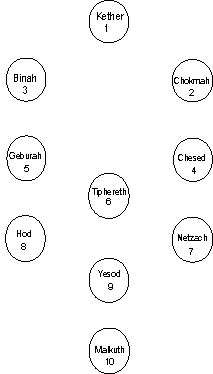
Upon this concept of the Sephiroth representing the qualities or activities of God theories of emanation began to develop, along with a theory of planes or worlds through which the Sephiroth emanated. Emanation in the Kabbalah consists of the idea that each Sephiroth produces the next. Concepts from which these theories formed are first found in the Sefir ha-Bahir and the works of Azriel of Gerona. These theories built upon the ideas developed by the earlier Kabbalistic schools of Provence and were combined with them.
This type of thought leads naturally to the idea that Kether emanated out of nothing, Ain (
nY)). Later schools of Kabbalists expanded this concept by dividing Ain into three concepts or levels of abstraction.These concepts are called Ain Soph (
PWS nY)), or without limit emanated from or below Ain, and Ain Soph Aur, (RW) PWS nY)) or limitless light emanated from Ain Soph. Together these conceptions are known as the Three Veils of Negative existence and are placed before Kether.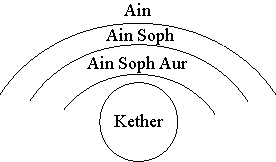
Emanation can be understood by considering a mystical interpretation of the Tetragrammaton [
HWHY] and then associating the four letters with the Sephiroth and the four worlds or planes through which the Sephiroth emanate.The following is a formula used in Western Esoteric Tradition:
Y
Yud: Represents the formulation of the first creative force, the supernal father who is "self-begotten". Associated with the element of Fire.H
Heh (Called Heh Superior): The addition of this letter represents the marriage of the Father with the co-equal mother. Associated with the element of Water.W
Vahv: The son who is brought about by the union of the Father and Mother, partaking of both their natures. Associated with the element of Air.H
Heh (Called Heh Inferior): The daughter who is both the twin sister and daughter of Vahv. Associated with the element of Earth.
This scheme is applied in several different fashions to the Sephiroth:
Kether (1) is the unity from which the father and mother spring, the father is Chokmah (2) the mother is Binah (3) , the son is Chesed-Yesod (4-9) and the daughter is Malkuth (10).
The four worlds or planes as associated with the Sephiroth and the Tetragrammaton (Here you can see a major quality of Kabbalistic thought, the ability to apply the same scheme or model over and over to different subjects to describe different processes and thoughts.):
Ha-olam Atzilut – the world of Archetypes, the plane where the powers of god exist. Analogous to Yud (
Y), includes the 1st – 3rd Sephiroth.Ha-olam B’riyah – the world of Creation, the plane of the archangels. Analogous to Heh Superior (
H), includes the 4th – 6th Sephiroth.Ha-olam Yetzirah – the world of Formation, the plane of the choirs of angels. Analogous to Vahv (
W), includes the 7th – 9th Sephiroth.Ha-olam Assiah – the world of Action, the plane where the physical universe exists. Analogous to Heh Inferior (
H), comprised of the 10th Sephiroth.In this scheme Heh Superior (the Mother) and Vahv (the Son) overlap somewhat, as Vahv is associated directly with Tiphareth, being a reflection of Kether his father.
These worlds can be explained by the actions that occur when you construct something, such as a table. First you see a need, this is the world of Atzilut. Then you begin to conceive of what the object should look like, it has four legs and a flat surface, etc… Here you are in the world of B’riyah. You go buy the materials and tools and actually fashion a table, this is the world of Yetzirah. When the table comes into use you are in the world of Assiah.
Diagram showing the division of the Sephiroth into the four worlds:
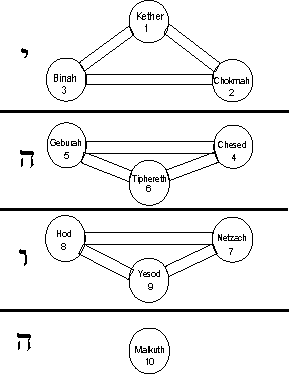
This diagram also illustrates another division of the Sephiroth into three triangles. The upper triangle composed of Kether, Chokmah and Binah form the Celestial Triangle, pointing up. Chesed, Geburah and Tiphareth form the Moral Triangle, pointing down. Netzach, Hod and Yesod form the Mundane Triangle, pointing down.
The idea that the first three Sephiroth exist in Atzilut, a purely spiritual realm, gives rise to another important division. The Sephiroth below Binah, 4-10, are treated in a different fashion, applying to more material concepts, things "outside the mind of god" whereas the Sephiroth of the Celestial Triangle represent the thought process within god’s mind itself. The lower 7 Sephiroth are related to the 7 days of creation, the 7 planets, the 6 directions of space plus a center point, etc… This type of division is prominent in the Sefir Sephiroth.
Another common arrangement is called the three pillars. This illustrates a concept that exists throughout the Kabbalah, the idea that all things below Kether exists in the form of two opposites, and a third principle which unifies them. This concept is illustrated by the triangles formed above. Wisdom (2) and Understanding (3) are unified in the ultimate (1), Strength (5) and Mercy (4) are unified in Beauty (6), Victory (desire, movement,7) and Stability (splendor,8) are unified in Yesod (9), the foundation of the material world (10). The entire tree is divided in a similar fashion, The Pillar of Severity and the Pillar of Mercy unified in the middle pillar, The Pillar of Mildness.
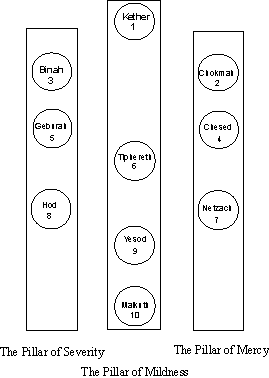
This division of the tree clearly demonstrates a basic Kabbalistic doctrine. One cannot be exclusively severe employing only Understanding (3) and Strength (5) to arrive at a false Splendor (8), or exclusively merciful employing only Wisdom (2) and Endurance (4) to arrive at a false Victory (7). One must combine all of these qualities to build a Foundation (9) for your Kingdom (10) , and win true Beauty (6) and the Crown(1).
An 11th Sephiroth began to be theorized as representing Knowledge, Da’ath. This represents a lower unification of Chokmah and Binah, forming another triangle pointing down. It is also called the abyss, separating the rest of the Sephiroth from the Sephiroth of the Celestial Triangle. This Sephiroth is usually not pictured, for it does not represent a unified concept – all in the abyss is in perpetual confusion. It represents the sum total of human knowledge, which after a fashion separates us from the divine.
The 22 letters of the Hebrew alphabet are split into three distinct groups: 3 mother letters, 7 double letters, and 12 single letters.
Together with the 10 Sephiroth they form the 32 Paths of Wisdom.
They appear in our diagram as paths between the Sephiroth, and can be understood as the interrelation of the two Sephiroth which they connect. The Sephiroth can also be considered as static qualities and the paths as the dynamic forces acting between them.
There is a correspondence between the first ten letters of the alphabet (often called the Aleph-Beth after the first two letters) and the ten Sephiroth themselves. The attributions of each of the letters are based upon the Sefir Yetzirah, following the grouping of the letters described above.
The three Mother Letters are attributed to the three elements, earth is often considered a mixture of the other three:
)
– Aleph, AirM
– Mem, Water#
- Shin, FireThe seven Doubles are attributed to the seven planets. I have read translations of two texts of the Sefir Yetzirah giving two different arrangements of the planets and seven double letters. The system I am familiar with and understand reflects neither of these, what follows is the arrangement used by the Hermetic Order of the Golden Dawn:
B
– Beth, MercuryG
– Gimel, MoonD
– Daleth, VenusK
– Kaph, JupiterP
– Peh, MarsR
– Resh, SunT
– Tau, SaturnThe twelve single letters, called the elementals, are attributed to the 12 signs of the Zodiac:
H
– Heh, Aries L – Lamed, LibraW
– Vahv, Taurus N – Nun, ScorpioZ
– Zayin, Gemini S – Samekh, SagittariusX
– Cheth, Cancer ( - Ayin, Capricorn+
- Teth, Leo C – Tzaddi, AquariusY
– Yud, Virgo Q – Qoph, PiscesThe 22 letters are numbered as "paths" 11 – 32, where the Sephiroth make up the first 10. They are numbered in the traditional order of the alphabet. If you are familiar with the trumps of the Tarot decks derived from the Hermetic Order of the Golden Dawn (such as the Rider-Waite deck, Waite being a member of the order) the following correspondences will be invaluable to understanding the nature of the paths, or vice-versa. The notes in brackets point out the changes in this arrangement present in the Thoth tarot deck.
Path Letter Number Tarot Trump
11 Aleph 0 The Fool
12 Beth 1 The Magician
13 Gimel 2 The High Priestess
14 Daleth 3 The Empress
15 Heh 4 The Emperor [Tzaddi]
16 Vahv 5 The Hierophant
17 Zayin 6 The Lovers
18 Cheth 7 The Chariot
19 Teth 8 Strength [Lamed – Adjustment]
20 Yud 9 The Hermit
21 Kaph 10 The Wheel of Fortune
22 Lamed 11 Justice [Teth – Lust]
23 Mem 12 The Hanged Man
24 Nun 13 Death
25 Samekh 14 Temperance [Art]
26 Ayin 15 The Devil
27 Peh 16 The Tower
28 Tzaddi 17 The Star
29 Qoph 18 The Moon
30 Resh 19 The Sun
31 Shin 21 The Last Judgment [The Aeon]
32 Tau 22 The World [The Universe]
The arrangement of the paths (11-32) between the Sephiroth varies greatly with different sources. Traditional texts such as the Sefir Yetzirah and the Sefir Bahir do not give this matter much attention at all. Most modern literature on the subject is derived from the system of the Hermetic Order of the Golden Dawn (Israel Regardie, Donald Michael Craig, Chic and Tabetha Ciciro, etc.).
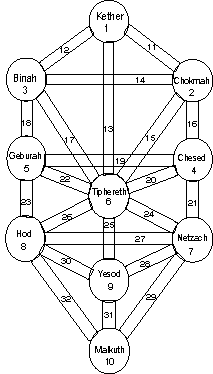
I personally greatly prefer another arrangement presented by Charles Stanford Jones (Frater Achad). In this system the three paths on the middle pillar correspond to the three mother letters. If you consider the astrological attributions of the Sephiroth and the paths you will find that in all but one case paths representing the signs of the Zodiac are connected to Sephiroth related to their ruling planet. Notice that the paths seem to "descend" down the tree in the Golden Dawn system and in this system they "rise".
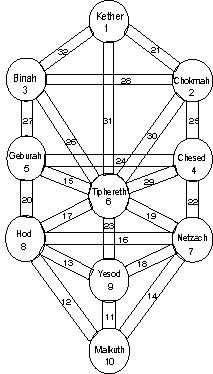
In the 13th and 14th century writings began to surface containing detailed theories concerning creation and the evolution of the universe. The Zohar, recorded (some say composed) by Moses b. Shem Tov de Leon in Spain is the first record of the theories we will study. The Zohar consists of as many as 24 major sections or books. We will cover the theories or models called "The Breaking of the Vessels" and Tikkun or restoration. These theories are greatly expanded in the work of Isaac Luria, called the Ari. Isaac Luria, a member of the Kabbalistic communities that arose in Israel, particularly in Safed, in the 16th century greatly expanded these theories. In my opinion these theories are also present in the Sefir ha-Bahir, but are not immediately evident unless one considers the work carefully.
The theory of the "Breaking of the Vessels" is the idea that during the creation of the universe the ten Sephiroth came into existence as purely spiritual conceptions. These Sephiroth are called vessels because they are containers for the light of the divine. As the power of the divine filled these vessels they broke because they could not contain the light. The lower Sephiroth completely shattered, and the entire tree "fell" into lower plains. The remains of the shattered Sephiroth are often called Kelliphot (shells). It is stressed in many works that the reason these original Sephiroth could not contain the light was because they were imperfect. In order to contain the light of the divine the Sephiroth would have to be like the divine. These Sephiroth could only receive, and could not give. The divine both gives and receives, thus these Sephiroth were not like the divine and could not contain the light.
Immediately upon "falling" the Sephiroth began a process of restoration (Tikkun). This process involves the raising up of the ten Sephiroth back to their original place in the universe, before the fall. The original state of the Sephiroth is known as Adam Kadmon, the primordial man. The Zohar also represents these original Sephiroth as the Kings of Edom, as worlds that were not "balanced", containing too much Din or Geburah. As the Sephiroth are restored they form Parsufim or faces. There are five Parsufim formed from the restored Sephiroth, Arikh Anpin or the long face containing Kether. Abba or the father contains Chokmah, Immu or the mother contains Binah. The next 6 Sephiroth form Ze’ir Anpin or the short face. Nukba de-Ze’ir, the female counterpart of Ze’ir Anpin contains Malkuth. Note the correlation to the first arrangement of
HWHY and the Sephiroth given in these notes. This process of Tikkun is approaching completion, the last stages of the process are the responsibility of man to complete. Upon completion the restored Sephiroth will be capable of both giving and receiving, and will thus be able to contain the light of the Divine.Another interesting theory that is first recorded in the works of 13th century Spanish Kabbalists is that of Shemittot, the idea that the world or universe progresses through a series of stages, related to the lower 7 Sephiroth. Each age or Shemittah lasts for 7,000 years, but many writers comment that these numbers are not to be taken literally (a common theme throughout Kabbalistic writings). The actual lengths of each Shemittah is dependent on its nature, and there is a concept of the movement of the planets and stars slowing as this process continues. The theory as commonly stated would place us currently in the Shemittah of Din, associated with Geburah. We are approaching the Shemittah associated with Tiphareth, an age of beauty and peace. The Torah and the Divine Name are interpreted differently during each Shemittah, thus in the previous Shemittah of Chesed, the interpretation of the Torah did not contain the prohibitions and strong sense of judgment as it does now, in the Shemittah of Din. At the end of this progression, the 7th Shemittah which represents a sort of combination of all of the previous Shemittah, the lower 7 Sephiroth will all be re-absorbed into Binah and the process of emanation will begin again creating a new universe.
Addendum: Frater Rishon Riza
The basis for all perfected diagrams of the tree should be the vesica picis. This is explained in such a way that I dare not try to duplicate, in Frater Achad's work The Anatomy of the Body Of God. I had a glimmer of understanding during previous incarnations (such as Frater Credo Quia Absurdum above) but the true import of this idea hits me just now, as Frater Rishon Riza, perhaps an effect of my work with the Tantric system with which I have become accustomed.
Back to Main Page